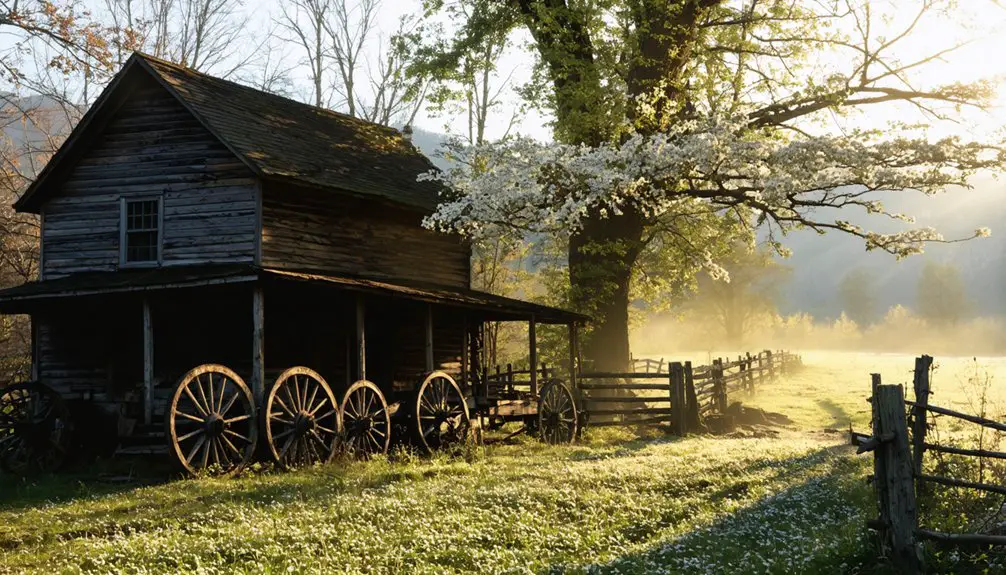You’ll find Devonia, originally called Moore’s Camp, tucked away in Anderson County’s remote valleys as one of Tennessee’s most complete coal mining ghost towns. The settlement thrived from 1910 through the early 2000s, centered around the Baldwin Coal Preparation Plant and a 42-mile railroad connection to Oneida. Today, nature reclaims the crumbling foundations, rusted tipples, and weathered ruins, while cemetery stones and mechanical remnants tell deeper stories of this company town’s industrial past.
Key Takeaways
- Devonia, also known as Moore’s Camp, was a significant mining settlement in Anderson County, Tennessee, established around 1910.
- The town operated as a company-controlled coal mining community with the Baldwin Coal Preparation Plant as its industrial center.
- Railroad infrastructure connected Devonia to Oneida via a 42-mile line, facilitating the transport of up to 125 coal cars daily.
- Economic decline began in the early 21st century, with mining jobs dropping dramatically and the eventual closure of community services.
- Today, Devonia exists as a ghost town with crumbling foundations, rusted coal tipples, and remnants hidden among mature forests.
The Birth of Moore’s Camp
While coal mining drove industrial development throughout Appalachia in the early 20th century, Moore’s Camp emerged as a significant mining settlement in Anderson County, Tennessee.
You’ll find the community’s origins deeply rooted in the coal industry’s expansion, with the establishment coinciding with growing railroad development in the region. The Tennessee Railway’s 1910 line extension brought critical infrastructure to support the area’s mining operations. Similar to other disambiguation entries, multiple locations shared the Devonia name during this period.
The settlement’s community origins reflect the era’s mining culture, gaining official recognition when the Devonia post office opened in 1920.
You’ll discover that while the U.S. Post Office knew the area as Devonia, locals embraced the name Moore’s Camp.
The camp’s strategic location along a 42-mile railway connecting to Oneida proved crucial for coal transport, particularly through the Paint Rock Coal & Coke Company’s operations, which later became part of Tennessee Railway.
Coal Mining Legacy
The Baldwin Coal Preparation Plant formed the heart of Devonia’s industrial operations, processing coal extracted from the surrounding mines throughout Anderson County.
You’ll find that coal extraction shaped the entire region’s development, with a sophisticated network of mining infrastructure connecting communities like Rosedale, Fork Mountain, Braytown, and Charley’s Branch.
The operation’s cornerstone was a 42-mile railroad system linking Devonia to Oneida, essential for transporting the processed coal to market. The Tennessee Railroad line remained active through peak production in the 1970s before declining operations began.
Mining technology and coal processing at the Baldwin Plant drove the local economy through much of the 20th century, sustaining multiple company towns and their workforce.
When coal demand declined, the region’s fortunes followed suit, leaving behind industrial remnants and abandoned facilities that tell the story of Devonia’s once-thriving coal industry.
Today, the overgrown and vandalized Baldwin Plant stands as a silent testament to the area’s coal mining heritage.
Life in a Company Town
Since Devonia operated as a quintessential coal company town, you’ll find that every aspect of daily life revolved around the mining company’s control.
You’d have rented your home from the company, shopped at company-owned stores, and followed strict rules governing your behavior and social obligations.
Life wasn’t easy under this system of company ownership. Workers faced grueling conditions in the mines, leading to labor strikes like the notable 1891 Tennessee Coal and Mining Co. protest.
Under the crushing weight of company control, miners endured brutal conditions until desperation sparked the 1891 Tennessee Coal strike.
When workers tried to advocate for better conditions, companies often responded by replacing them with convict laborers, particularly exploiting Black workers through the convict leasing system.
Your social activities, church attendance, and even your children’s education fell under company oversight, creating a community where personal autonomy was severely limited. The steep grade conditions made transportation challenging and further isolated the community, as trains could only pull a limited number of cars up the mountainside.
Transportation Hub and Railroad Connection
As mining operations expanded in Devonia, railroad connectivity became the lifeline of this coal-dependent community.
You’d find the Tennessee Railroad extending 42 miles from Oneida to Devonia by 1912, with branch lines snaking through Smoky Creek and beyond. The railroad logistics were impressive, handling up to 125 coal cars daily during peak operations between 1970 and 1980.
The transportation networks grew more complex as plans emerged to connect with the Harriman & Northeastern Railroad at Petros, potentially linking to larger railways like Southern Railway and Louisville & Nashville.
Though some expansions didn’t materialize due to economic challenges, the railroad’s presence transformed Devonia into a crucial coal transportation hub, complete with a coal preparation plant that processed the region’s valuable resources. The line’s recent challenges include serious vandalism since 2013, impacting historic equipment and infrastructure.
Post Office Era: 1920-1975
Devonia’s post office, established in 1920, served as the central mail distribution hub for several coal mining communities including Moore’s Camp, Rosedale, Fork Mountain, Braytown, and Charley’s Branch.
You’ll find that during its 55-year operation, the facility handled essential postal services while acting as a crucial community center for local miners and their families. Historical records show the post office maintained regular notifications to keep residents informed about mail services and community updates. The Tennessee State Library maintains detailed records of the facility’s operations.
The post office’s presence supported the region’s communication needs until 1975, when declining mining activity and subsequent population loss led to its closure.
Mail Distribution Network
When the Devonia post office opened its doors in 1920, it established an essential communication hub that would serve Anderson County’s coal mining communities for over five decades.
You’d find mail routes extending to Rosedale, Fork Mountain, Braytown, and Charley’s Branch, with the post office coordinating both rail and road deliveries across challenging mountain terrain.
The facility’s 42-mile railroad connection to Oneida proved significant for managing community correspondence, linking isolated mining camps to the broader world.
You could rely on the post office to handle personal letters, business documents, and critical coal industry communications.
The network’s efficiency depended on careful coordination between incoming rail shipments and outbound local deliveries, ensuring that even the most remote settlements maintained their connection to civilization through this essential postal lifeline.
Community Hub Operations
The Devonia post office quickly evolved beyond its basic mail-handling duties to become the heart of community life from 1920 to 1975.
You’d find residents gathering regularly to collect their mail and engage in crucial community connections, especially during the peak years of coal mining operations. The post office served as an essential hub where postal services merged with social interaction, linking the communities of Rosedale, Fork Mountain, Braytown, and Charley’s Branch.
Key functions of this community anchor included:
- Facilitating business operations through commercial document handling
- Enabling communication between isolated mining families
- Providing a central meeting point for news exchange and social gathering
The facility’s integration with local mining infrastructure made it particularly accessible, while its presence helped maintain the area’s economic significance until its closure coincided with the region’s mining decline.
Daily Life in the Mining Community
Life in Devonia’s mining community revolved around the demanding coal industry that shaped every aspect of residents’ daily routines. You’d find miners walking to their shifts at all hours, heading into the depths for long hours of physically demanding work. The mining culture centered around tight-knit family bonds and mutual support, essential for surviving the harsh realities of coal camp life.
Community traditions flourished around the local general store, schools, and churches. You’d see children attending Rosedale Elementary while their fathers worked the mines, and families gathering for church events and outdoor activities during precious leisure hours. The town’s position as part of Tennessee made it an integral hub for regional coal production.
The wooden frame houses, clustered near the coal preparation plant and railroad, created an interconnected neighborhood where everyone relied on each other, sharing both the hardships and simple pleasures of mining town life.
Economic Decline and Abandonment
Devonia’s thriving coal-based community began unraveling in the early 21st century as market forces and environmental regulations dealt devastating blows to the region’s primary industry.
You’ll find that the town’s lack of economic resilience became evident as employment plummeted from 267 miners to just 88 by 2015, while coal prices dropped 25%.
The cascade of decline manifested in three critical ways:
- Railroad operations ceased, despite a $5 million investment in infrastructure
- Community services, including schools and shops, shuttered permanently
- Housing conditions deteriorated as population dwindled
While attempts at community reinvention through tourism and recreation emerged, they couldn’t match coal’s economic impact.
The Tennessee Railroad’s closure and National Coal Company’s near-bankruptcy in 2010 marked the final chapters in Devonia’s transformation from bustling mining town to ghost town, eventually leading to the extraction of the last ton of coal in June 2022.
Modern Day Remnants
While nature steadily reclaims what remains of this once-thriving coal town, you’ll find scattered structural remnants that paint a haunting portrait of Devonia’s past.
Through vegetation reclamation, mature hardwoods and pines now tower over crumbling foundations and rusted coal tipples. Your remnants exploration will reveal old wooden beams, mechanical parts, and household artifacts like ceramic fragments beneath layers of soil.
You can access the site via unpaved rural roads, though you’ll need to exercise caution due to unstable structures.
The cemetery stones still stand as silent witnesses, their inscriptions preserving the names of former residents. While informal cleanup groups occasionally maintain the area, nature continues its slow conquest, transforming this industrial settlement into a wild landscape where wildlife now thrives among the ruins.
Historical Significance in Tennessee Coal Country
Beyond the weathered ruins lies a rich historical tapestry that shaped Tennessee’s coal country. When you explore Devonia’s cultural heritage, you’ll discover a crucial hub that served multiple mining communities, including Rosedale, Fork Mountain, and Braytown. The establishment of the post office in 1920 marked Devonia’s emergence as a significant center for the region’s coal operations.
Devonia stands as a testament to Tennessee’s coal heritage, where weathered ruins whisper stories of bustling mining communities and industrial prosperity.
Mining technology and infrastructure developments were central to Devonia’s role:
- The Baldwin Coal Preparation Plant processed coal using advanced methods for its time.
- A strategic 42-mile railway connection to Oneida facilitated efficient coal transport.
- The Trimore Coal Corporation’s operations showcased post-WWII mining techniques.
You can trace Devonia’s influence through its company town structure, where the coal industry didn’t just employ workers – it shaped entire communities, from schools to social systems.
Frequently Asked Questions
Are There Any Remaining Structures or Buildings Still Standing in Devonia Today?
You won’t find any confirmed remaining buildings in Devonia today, as historical preservation wasn’t prioritized after mining ceased, and typical coal town structures weren’t maintained or documented for posterity.
What Was the Peak Population of Devonia During Its Mining Heyday?
Picture coal dust rising over rows of company houses – you’d have seen around 300-500 residents during the mining boom years of the 1920s-1940s, before mechanization triggered population decline.
Were There Any Major Mining Accidents or Disasters in Devonia?
You won’t find any major mining disasters in historical records for this location. Mining safety documentation and accident reports don’t show significant incidents, though the area primarily operated as a coal preparation camp.
What Happened to the Residents After the Town Was Abandoned?
Like scattered coal dust in the wind, you’ll find residents’ stories spread across nearby towns like Briceville and Oneida, where families sought new opportunities while others joined mining communities in surrounding states.
Is It Legal to Visit and Explore Devonia’s Ghost Town Remains?
You’ll need to verify ghost town regulations and obtain exploration permits before visiting, as most abandoned mining sites are private property and require explicit landowner permission for legal access.
References
- https://www.tnvacation.com/articles/ghost-towns-tennessee
- https://www.tnmagazine.org/19-ghost-towns-in-tennessee-that-are-not-underwater/
- https://en.wikipedia.org/wiki/Devonia
- https://www.islands.com/1908975/hidden-tennessee-north-carolina-border-abandoned-town-mossy-trails/
- https://en.wikipedia.org/wiki/List_of_ghost_towns_in_Tennessee
- https://abandonedonline.net/location/tennessee-railroad/
- http://www.coalzoom.com/article.cfm?articleid=26357
- https://www.houseofhighways.com/nearby/usa/southeast/tennessee/moores-camp
- https://ancestors.familysearch.org/en/LVDP-CTD/elisha-daugherty-1898-1954
- https://pubs.usgs.gov/pp/0572/report.pdf



